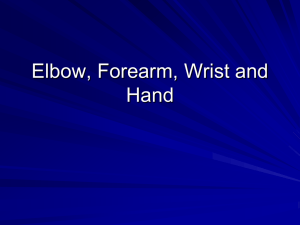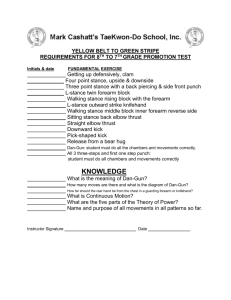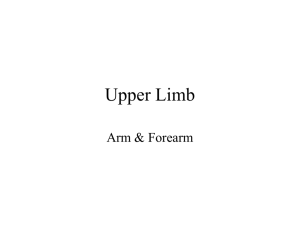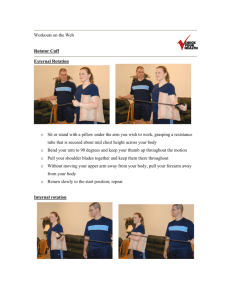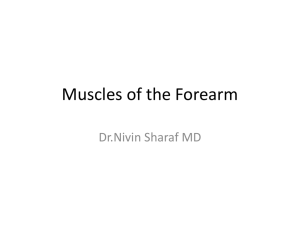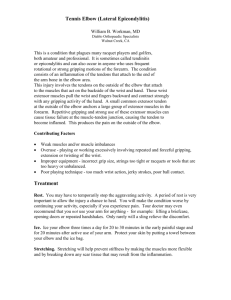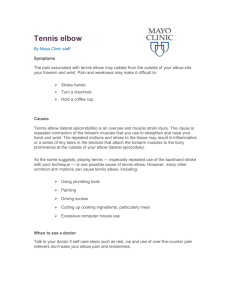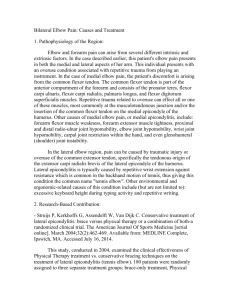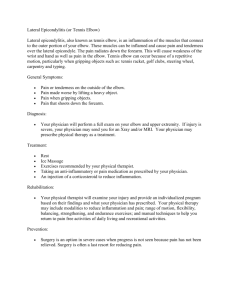Upper Extremity Outline
advertisement
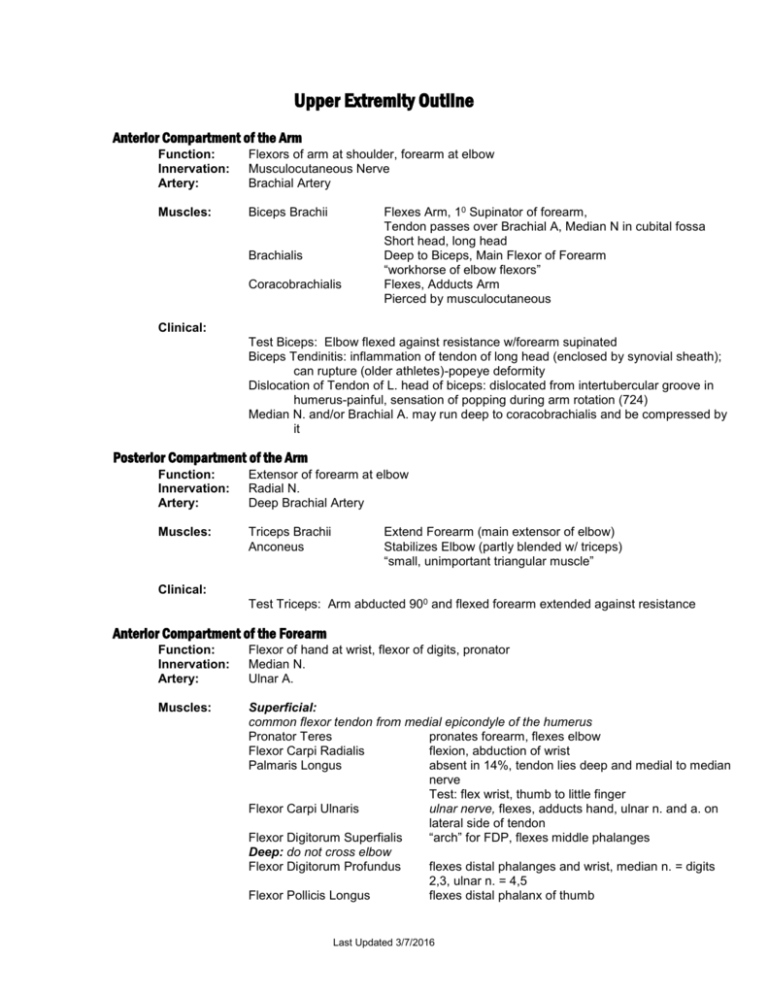
Upper Extremity Outline Anterior Compartment of the Arm Function: Innervation: Artery: Flexors of arm at shoulder, forearm at elbow Musculocutaneous Nerve Brachial Artery Muscles: Biceps Brachii Brachialis Coracobrachialis Flexes Arm, 10 Supinator of forearm, Tendon passes over Brachial A, Median N in cubital fossa Short head, long head Deep to Biceps, Main Flexor of Forearm “workhorse of elbow flexors” Flexes, Adducts Arm Pierced by musculocutaneous Clinical: Test Biceps: Elbow flexed against resistance w/forearm supinated Biceps Tendinitis: inflammation of tendon of long head (enclosed by synovial sheath); can rupture (older athletes)-popeye deformity Dislocation of Tendon of L. head of biceps: dislocated from intertubercular groove in humerus-painful, sensation of popping during arm rotation (724) Median N. and/or Brachial A. may run deep to coracobrachialis and be compressed by it Posterior Compartment of the Arm Function: Innervation: Artery: Extensor of forearm at elbow Radial N. Deep Brachial Artery Muscles: Triceps Brachii Anconeus Extend Forearm (main extensor of elbow) Stabilizes Elbow (partly blended w/ triceps) “small, unimportant triangular muscle” Clinical: Test Triceps: Arm abducted 900 and flexed forearm extended against resistance Anterior Compartment of the Forearm Function: Innervation: Artery: Flexor of hand at wrist, flexor of digits, pronator Median N. Ulnar A. Muscles: Superficial: common flexor tendon from medial epicondyle of the humerus Pronator Teres pronates forearm, flexes elbow Flexor Carpi Radialis flexion, abduction of wrist Palmaris Longus absent in 14%, tendon lies deep and medial to median nerve Test: flex wrist, thumb to little finger Flexor Carpi Ulnaris ulnar nerve, flexes, adducts hand, ulnar n. and a. on lateral side of tendon Flexor Digitorum Superfialis “arch” for FDP, flexes middle phalanges Deep: do not cross elbow Flexor Digitorum Profundus flexes distal phalanges and wrist, median n. = digits 2,3, ulnar n. = 4,5 Flexor Pollicis Longus flexes distal phalanx of thumb Last Updated 3/7/2016 Pronator Quadratus pronates forearm, deepest of flexors Clinical: Anterior communicates w/ central compartment of palm through carpal tunnel Posterior Compartment of the Forearm Function: Innervation: Artery: Extensor of hand, digits, supinator Radial N. Radial A. Muscles: Bracioradialis Supinator Flex forearm, overlies radial a. and n. Supinates forearm, helps form floor of cubital fossa, deep branch of radial nerve passes b/t 2 parts of supinator Extend/Adduct hand at wrist Extensor Carpi Radialis Longus *Extensor Carpi Radialis Brevis *Extensor Carpi Ulnaris Extend Medial 4 digits *Extensor Digitorum Extensor Indicis *Extensor Digiti Minimi Extend/Abduct 1st digit Adductor Pollicis Longus Extensor Pollicis Longus Extensor Pollicis Brevis Extend, Abduct Hand Extend, Abduct Hand Extend, Adduct Hand, Stabilizes Elbow principle extensor of 4 digits Extend index finger at PIP joint Abductor of thumb, extend thumb (lat side of snuffbox) Ex distal phalanx of thumb, Adducts thumb (medial side of snuffbox) Extend distal phalanx of thumb (Lat side of snuffbox) *=superficial Clinical: “hood” over extensor tendons of digits by extensor expansions Mallet Finger (Baseball finger): severe tension on a long extensor tendon may avulse part of its attachment to phalanx Radial artery: floor of snuffbox If a superficial vessel in forearm is pulsating, it could be a superficial radial or ulnar a. Pronator syndrome: median nerve compressed near elbow between heads of pronator teres Major Nerves: Musculocutaneous N. Radial N. Median N. Ulnar N. Injury can be caused by weapon-paralysis of Biceps, Coracobrachialis, Brachialis-flexion of elbow and supination weakened posterior compartment When injured in radial groove, triceps not completely paralyzed, sign of injury: wrist-drop (wrist flexed due to opposed tonus of flexor muscles and gravity) 731, Inappropriate use of crutches can compress nerve at axilla (weight inappropriately put on axilla instead of hands when using crutches) No branches in axilla or arm Injury: when patient attempts to make fist, digits 2, 3 partially extended (hand of benediction) Compression at elbow common (numbness, tingling in medial part of palm, little, ring finger)-difficulty making fist “clawhand” Innervates interosseous muscles-inability to adduct digits=classic sign of injury Last Updated 3/7/2016 Major Arteries Brachial A.: To find pulse, push laterally not deeper Major Cutaneous Structures: Cephalic Vein Anterolateral Surface of arm, passes between deltoid and pectorailis major Basilic Vein Other Clinical: Subluxation of Elbow (pulled elbow) in preschool kids: esp. girls, child lifted (jerked) by upper limb while forearm pronated-tears distal attachment of anular ligament, radial head moves distally-pain from pinched anular ligament-Tx-supination of child’s forearm with elbow flexed Colles’ fracture: most common fracture in people >50, fracture of distal end of radius fractured, often distal fragment broken into pieces, “dinner-fork deformity” (distal fragment overrides rest of bone, displaced posteriorly), distal radioulnar joint subluxated, usually slipping and using outstretched hand to break fall Brachial Plexus Injury to Superior part (C5-C6): result from excessive incr in angle b/t neck and shoulder (thrown or newborn in delivery); waiter’s tip postion (arm hangs by side in medial rotation) Erb’s Palsy paralysis of muscles supplied by C5-C6 Backpacker’s palsy upper brachial plexus injury to musculocutaneous, radial nerve distribution Acute brachial plexus neuritis (brachial plexus neuropathy), unknown cause, severe pain around shoulder and muscle weakness, inflammation of brachial plexus Compression of cords hyperabduction of arm (painting, plastering ceiling), pain in arm, weakness of hand, red skin Last Updated 3/7/2016

